Year 6 March - Welcoming Spring to the Beeyard 🖊️
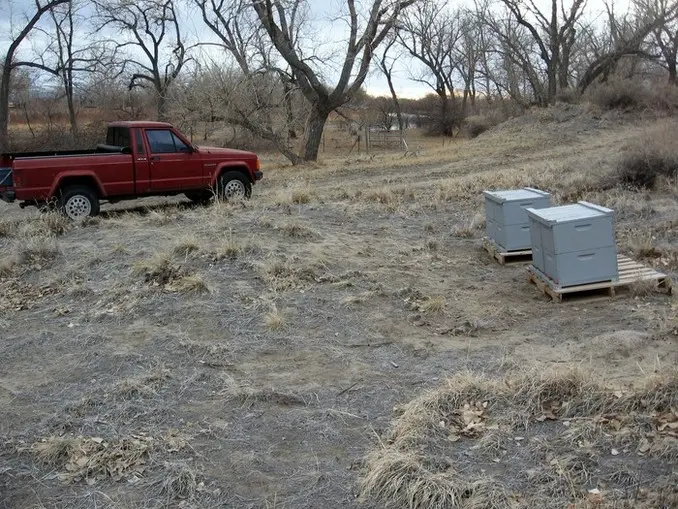
March brings the buzz back to the beeyard.
March Beeyard Chronicles - A Quick Check-In
Just enough time for a swift inspection, a feeder refill, and the reassuring sight of thriving, lively hives.
The Weather
The past few days have graced us with temperatures soaring above 60 degrees. Today mirrors that warmth, but a twist in the forecast predicts a temperature drop and the possibility of snow tomorrow. With time slipping away due to my day job, the storm is set to coincide with my availability.
- 3 pm: Beautiful weather, warm breeze.
- 4 pm: Warmth persists but ominous clouds creep in.
- 5 pm: A cooling trend, lowering clouds, and a hint of moisture in the air.
Botheration! I’m still at work, and it seems a feed check is slipping through my fingers.
As storms approach, winds often surge to 40 mph, and temperatures plummet by 30 degrees, sometimes within the hour.
Now, at 5:30 pm:
- The wind has ceased.
- It’s still warm.
- No precipitation.
Would meddling with the hives do more harm than good? My original plan to:
- Feed the lighter hives.
- Swiftly pull and inspect a brood frame.
- Document with a camera (extra buzz for the blog).
This time, brevity is the key.
- No covers or frames removed to preserve cluster warmth.
- Heft the hives.
- Quickly separate the deep bodies.
- Snap a photo.
- Top up the feeders.
- Note the hive’s status.
- Reassemble.
Here we go.
First Impressions
The hives appear much as I left them last September, which is excellent. Curious critters or vandals can easily cause damage. Last fall:
- Division board feeders were filled with granulated sugar.
- Covers securely nailed down.
- Hives pushed together.
- Positioned away from prevailing winds.
- Pallets tipped forward for proper drainage.
- Entrances reduced.
Today, there’s minimal bee activity. That’s fine; there’s nothing for them to work except water from the ice-cold river. Risky for a chilled bee to gather ice water on a marginal flying day—many never return.
Dead Bees
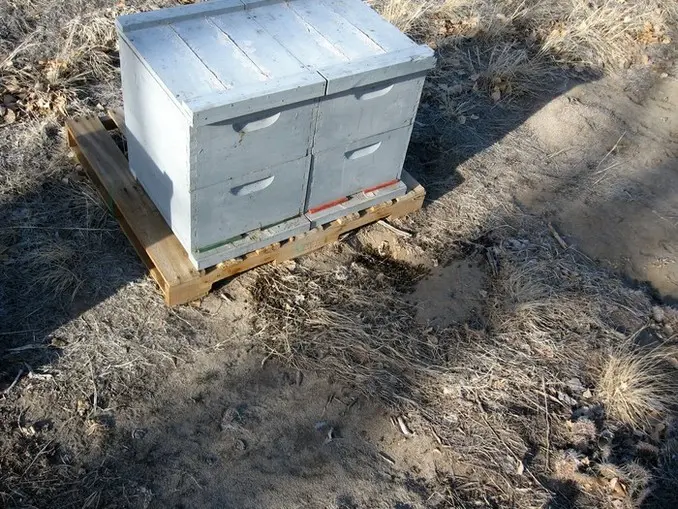
-A usual scattering of dead bees at the hive entrance after winter.
Each hive sports about a cup of crisply deceased bees in front. But there’s no:
- Large heaps of greasy-looking bees.
- No deceased crawlers clinging to the hive or nearby vegetation.
- No obvious deformed bees.
- No rejected brood.
No signs of trouble here.
The bees have congregated in depressions scratched out by skunks, but no recent skunk skat is visible. No skunk odor.
Stains
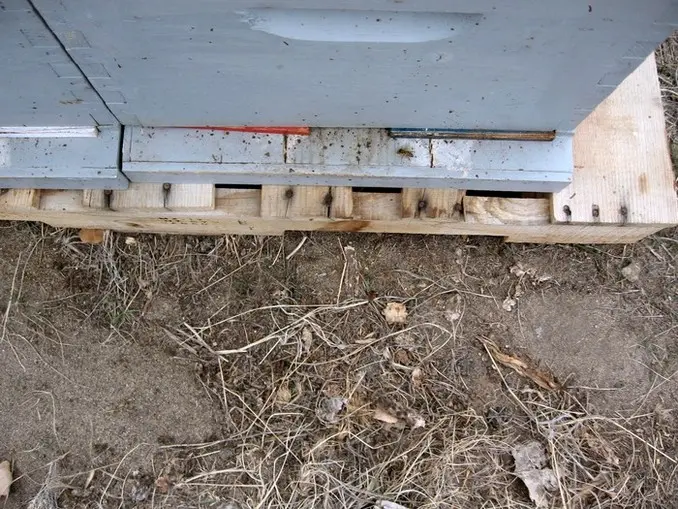
-Typical hive staining.
A few bees left droppings on the hives during too-cold-to-fly weather. Nothing unusual—no large accumulations or clumps.
Hefting
Time to light the smoker and give each entrance a gentle puff of cool, white smoke.
Hefting assesses a hive’s stores, lifting it 2″ to 6″ high from the rear handhold. It’s an art in beekeeping, influenced by local factors like:
- Time of year.
- Management style.
- Bee type.
Not hard to learn but requires experience.
- 2 hives are good.
- 1 hive is light.
- 1 hive has most honey on one side.
Opening Them Up
I could wrap it up now. The light hive is good for another 2 to 3 weeks; the others will last a month or more. But the weather is cooperating. Let’s crack them open and sneak a quick look inside.
- A light puff of smoke at the entrance.
- The hive tool gently separates the back edge of the boxes.
- The top box’s back edge is raised an inch.
- The hive tool frees any frames stuck together.
- The top box is set behind the hive.
- A quick photo.
- Feeders refilled.
- A gentle puff of smoke frees the bees off the bars.
- Trouble lookout.
- Close them up.
Light Hive
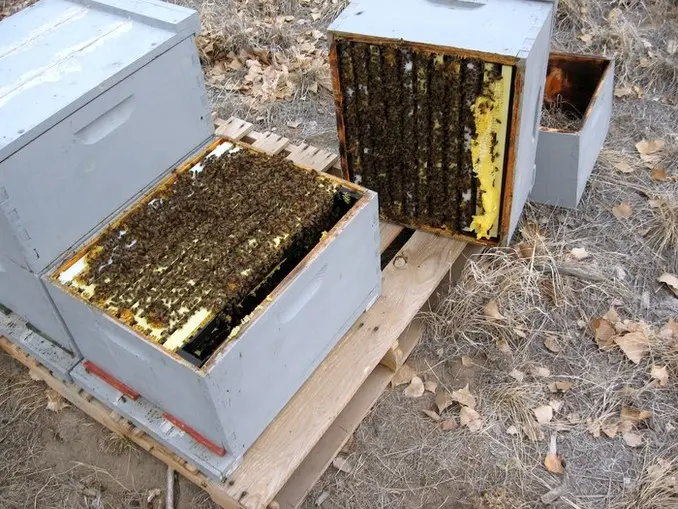
-A lightweight hive with an impressive cluster for Wyoming in March.
This lightweight hive is a marvel. No wonder it’s lighter—it harbors quite a bunch of bees for a Wyoming March:
- The feeder is empty.
- Sealed brood is present.
- No visible mites.
- No deformed bees.
- The hive has a healthy aroma.
This hive needs monitoring; with brood rearing picking up, starvation is a potential risk if the weather turns sour.
Lopsided Hive
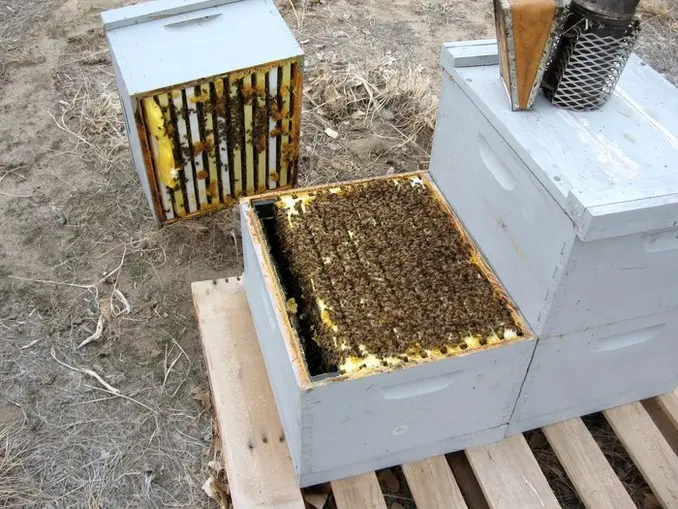
-An off-kilter hive with an abnormal weight distribution.
Abnormal weight distribution often signals an issue:
- The feeder is full.
- Five honey frames occupy the top box’s outside edge.
- The cluster is ample, boasting sealed brood and a clean bill of health.
Beekeeping mysteries abound—why did they cozy up to their neighbor? Perhaps they enjoyed the extra warmth, or winter winds caught them at an unusual angle.
Weaker Hive
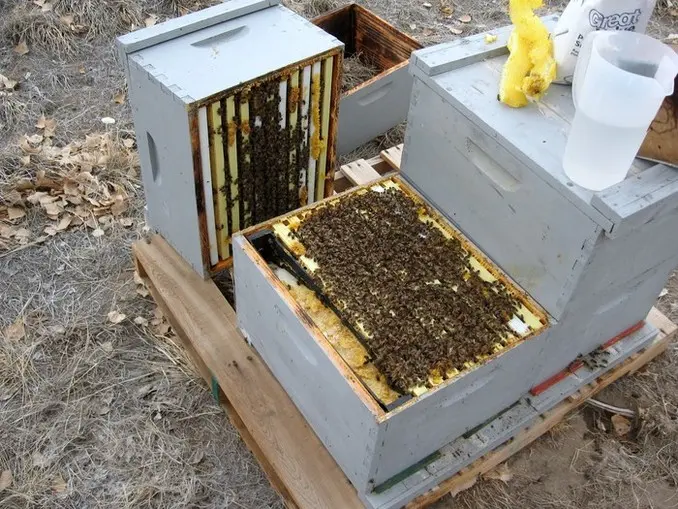
-A slightly weaker hive with an empty feeder.
This is the weaker hive, characterized by:
- An empty feeder.
- The top box is loaded with honey.
- A cluster that’s above average in size, contains sealed brood, and shows no signs of trouble.
Despite its lower population compared to other hives, this one is still robust. Left alone, I anticipate it becoming honey-bound and swarming quickly in warm weather. When the temperatures rise, I’ll likely swap some frames with its lighter neighbor.
Strongest Hive
The strongest hive blends a large bee population with massive honey stores. Unfortunately, no picture to show you. It was brimming with bees, feed, and health—too much to photograph without revealing all those overwintering secrets. It was the last hive I worked, and in my haste to button everything up, I forgot to snap a picture. Imagine that!
Phew!
Dodged the overwintering bullet. After transitioning to small cell and adopting a natural beekeeping approach, positive overwintering became the norm. I grew complacent. However, after returning from Florida and dealing with high virus loads from a commercial beekeeper, I faced slow-motion Colony Collapse Disorder.
Unaware, I experienced the multi-year decline and the demise of my bees. Old news for those following this blog.
It’s been a while since I’ve had such a positive overwintering experience. I no longer take it for granted, even with four hives.
For various reasons, this success was much-needed this year, and I’m grateful for it.
The Challenge
Maintaining such robust, healthy colonies in two deep hive bodies is a challenge. Previously, I’d overwinter these hives in three deep hive bodies. I could checkerboard them during this first yard check by:
- Placing the middle deep box with the cluster on the bottom board.
- Taking the bottom box with its pollen and mostly empty combs.
- Taking the top box with full honey frames.
- Alternating the full and empty frames in boxes.
- Setting them above the cluster box on the bottom board.
But with only two deeps of drawn comb, I can’t checkerboard until the weather warms significantly. By then, in Wyoming, it’s usually too late. They:
- Swiftly become honey-bound and swarm.
- Starve during the June dearth.
- Demand almost weekly inspections, causing much disruption.
Wyoming March
These bees are keeping me on my toes. March in Wyoming still feels like winter with a hint of spring. The first spring pollen is at least two weeks away, and dandelions won’t bloom for another two months. But that’s Wyoming’s climate.
For now, the temperature is still accommodating, and there’s enough light left for another season’s first. Assuming the motorcycle battery cooperates, I’m revving up the 1980 Honda CX500D for a spin. ✨
-Cheers, D 🌨️🐝
